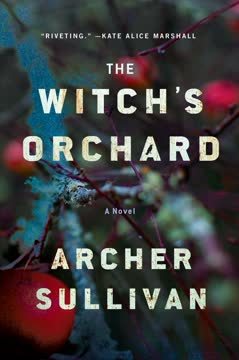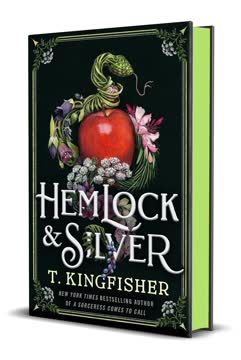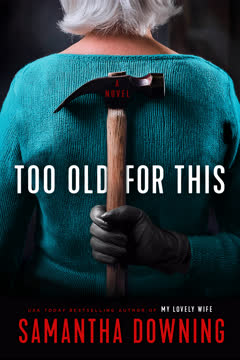Plot Summary
A Sad Job Begins
Annie Gore, a private investigator with a tough past, is hired by Max Andrews, a haunted young man desperate to find out what happened to his sister Molly, who vanished ten years ago in the small Appalachian town of Quartz Creek. Max's "casebook" is a scrapbook of pain: three little girls were taken, applehead dolls left in their place, and only one girl, Olivia, was ever returned. Annie, herself from the mountains, is drawn in by Max's determination and the echo of her own hardheadedness. She agrees to spend a week in Quartz Creek, knowing the odds are slim, but unable to turn away from the raw need in Max's eyes. The case is cold, the town is closed, and the wounds are deep.
Ghosts of Quartz Creek
Annie drives into Quartz Creek, a town hollowed by poverty and memory, and settles into Max's rustic rental cabin. The landscape is beautiful but heavy with secrets. Max's family is broken: his mother dead by suicide, his father absent, and Max left to carry the burden. The crows scream in the night, echoing the local legend of a witch who lost her daughters. Annie feels the weight of the past and the pain of families left behind. She begins to dig into the casebook, sensing that the town's wounds are still raw, and that the truth is buried deep beneath layers of silence and shame.
The Witch's Legend
Max recounts the legend of the Witch of Quartz Creek: a mother who, to protect her daughters, turned them into birds, only to lose them forever. The crows' nightly screams are said to be her cries. The story, passed down through generations, is more than folklore—it's a lens through which the town views its tragedies. Annie recognizes how myth and reality blur in places like this, where pain is explained away by stories, and where the line between witch and scapegoat is thin. The legend becomes a shadow over the investigation, coloring every suspicion and every memory.
Three Girls Taken
Annie learns the details: Jessica Hoyle, Olivia Jacobs, and Molly Andrews were taken in quick succession, each replaced by a handmade applehead doll. Only Olivia was returned, mute and traumatized. The town's response was suspicion and rumor—blaming the "trashy" Hoyles, whispering about scams, and questioning the competence of the local police. The FBI came, but found nothing. The families fractured under the weight of grief and guilt. Annie interviews the mothers, feeling the ache of their loss and the corrosive effect of a decade of unanswered questions.
The Returned and the Lost
Annie visits Olivia Jacobs, now a teenager, who has never spoken since her return. Her mother, Kathleen, is exhausted and defensive, her family splintered. Olivia communicates only through drawings—spirals, repeated endlessly. Annie senses that Olivia holds the key to what happened, but the trauma is locked deep inside her. The town's wounds are not just personal—they are collective, festering in every conversation and every glance. Annie feels the pressure to find answers, not just for Max, but for everyone left behind.
Applehead Dolls and Suspects
Annie interviews the Hoyles, the Jacobses, and the townsfolk, uncovering layers of resentment, poverty, and old grudges. The applehead dolls—grotesque, handmade, and symbolic—become a focal point. Theories abound: a local pervert, a trafficking ring, a ritualistic killer. The church, First Baptist, is at the center of community life and suspicion. The preacher, Bob Ziegler, and his wife Rebecca, are pillars of the town, but their presence at every key event is unsettling. Annie senses that the truth is tangled in the town's relationships, and that everyone is hiding something.
The Town's Wounds
As Annie digs deeper, her own past bleeds into the case. Memories of abuse, poverty, and survival surface, mirroring the pain she sees in Quartz Creek. She is drawn to Max's quiet strength, Shiloh's kindness, and the resilience of women like Mandy Hoyle and Kathleen Jacobs. The investigation is not just about finding a missing girl—it's about confronting the ways trauma shapes lives and communities. Annie's empathy becomes both her weapon and her vulnerability as she pushes against the town's resistance.
The Circle of Stones
Annie discovers a mysterious stone circle in the woods, a place where sound is amplified and crows gather. She meets Susan McKinney, the eccentric "witch" of the mountain, who offers cryptic warnings and herbal remedies. The circle becomes a symbol of the case: a place where the past reverberates, where secrets are kept, and where the boundary between the natural and the supernatural blurs. Annie feels watched, both by the living and the dead, and senses that the answers she seeks are hidden in the land itself.
The Old Woman in the Woods
Susan, rumored to be a witch, is both feared and sought after. She dispenses folk wisdom, reads cards, and knows everyone's secrets. Annie is unsettled by her, unsure if Susan is a red herring or a key to the mystery. Susan's own story is one of loss and survival, and she becomes a mirror for Annie's journey. The town's need for a scapegoat is palpable, and Susan's presence at the margins of society makes her both a suspect and a source of insight. Annie must decide how much to trust her instincts—and the stories people tell.
The Casebook and the Past
Max's casebook, a child's attempt to make sense of horror, is a trove of clues and obsessions. Annie pores over it, finding connections between the girls, the dolls, and the town's rituals. She learns about the day Molly vanished: a plumber on the property, a piano lesson, a mother in the garden, a "scarecrow" in the field. The details are mundane and surreal, hinting at both human and supernatural explanations. Annie realizes that the truth may be hidden in plain sight, disguised as everyday life.
The Church's Secrets
Annie investigates First Baptist, its preacher, and its congregation. The church is both sanctuary and stage, a place where the town's dramas play out. Bob and Rebecca Ziegler are everywhere—at the scene of each kidnapping, offering comfort and counsel. Their past is murky: Bob's military history, a scandal, a marriage without children. The church's influence is pervasive, and Annie suspects that its power has shielded secrets for years. The line between faith and fanaticism, protection and control, is thin.
The Plumber and the Scarecrow
Annie tracks down the plumber, Dwight Hoyle, who was on the Andrews property the day Molly vanished. He recalls seeing a "scarecrow" in the field—a figure in a black cloak. The detail is echoed by others, but its meaning is elusive. Dwight's own life is a mess of addiction and crime, and he becomes both a suspect and a victim. The scarecrow image haunts Annie, symbolizing the way evil can hide in the ordinary, and how trauma distorts memory. The investigation circles back on itself, always returning to the same unanswered questions.
The Artist's Grief
Max, a gifted artist, channels his pain into woodblock prints of crows and fields. His art is both a memorial and a plea for understanding. Annie sees in him the cost of unresolved grief—the way it freezes lives and stifles potential. Max's need for answers is not just about Molly; it's about freeing himself from the past. Annie realizes that her own healing is tied to the case, and that finding the truth is as much about the living as the dead.
The Festival and the Doll
During the church's Fall Festival, Shiloh's young daughter Lucy vanishes. In her place is another applehead doll, this time with hair that matches Molly's. Panic grips the town. The cycle has begun again, and the sense of dread is overwhelming. Annie feels responsible—her investigation has stirred up old dangers. The FBI is called in, but the town's trust in outsiders is thin. The urgency to solve the case is now doubled: Lucy's life hangs in the balance, and the past is repeating itself.
The Kidnapper Returns
As Annie closes in, she is shot at in the woods and takes refuge with Susan McKinney. The investigation accelerates: evidence points to Deena Drake, the reclusive widow on the mountain, whose house is full of secrets. Annie discovers a hidden panic room, a nursery for stolen girls. The truth is more twisted than she imagined: Deena, driven mad by grief and longing for children, kidnapped Jessica, Olivia, and Molly, with the help of a complicit sheriff. But the real danger is Jessica, now grown, who has become both victim and perpetrator.
The Witch's Orchard Revealed
In a final confrontation, Annie and Shiloh face Jessica, who has killed to preserve her fantasy of family. The "witch" is not Susan, but Deena—her orchard a prison, her love a curse. The legend of the witch is revealed as a metaphor for generational trauma, the way pain is passed down and transformed. The crows' cries are the echoes of mothers' grief, and the applehead dolls are tokens of loss and longing. Annie survives, but not without scars. The town is forever changed, but the cycle of silence is broken.
The Truth in the Panic Room
With Jessica in custody and Deena exposed, the truth comes out: the girls were hidden in plain sight, their suffering masked by the town's myths and the adults' failures. Max receives closure, but at a terrible cost. Annie, wounded but unbroken, leaves Quartz Creek changed. The town begins to heal, but the lessons linger: evil can wear many faces, and the only way to break the cycle is to confront the truth, no matter how painful. The witch's orchard is not just a place, but a legacy—and it is up to the living to tend it with honesty and courage.
Characters
Annie Gore
Annie is a private investigator with a military background and a history of trauma. Scarred by her own family's violence and poverty, she is both tough and deeply empathetic. Her connection to the mountains gives her insight into the town's insular ways, but also makes her an outsider. Annie's drive to solve the case is fueled by her need to heal her own wounds and to give others the closure she never had. She is relentless, self-deprecating, and fiercely protective of the vulnerable. Her relationships—with Max, Shiloh, and AJ—reveal her longing for connection, even as she resists it.
Max Andrews
Max is the heart of the story: a gentle, artistic young man whose life was shattered by his sister's disappearance. His casebook is both a record of pain and a desperate attempt to impose order on chaos. Max's quiet strength masks a deep well of grief and guilt. He is both a child and an old soul, forced to grow up too soon. His relationship with Annie is one of mutual recognition—they see in each other the scars of survival. Max's journey is about learning to let go, to live beyond the shadow of loss.
Shiloh Evers
Shiloh is Max's childhood friend and the town's baker, a single mother whose warmth and strength anchor the community. She is fiercely loyal, practical, and nurturing, providing comfort to Max and Annie alike. Shiloh's own trauma—her daughter's kidnapping—brings the case into the present and tests her resilience. Her relationship with Annie is one of mutual respect and support, and her actions in the climax reveal her courage and resourcefulness. Shiloh embodies the power of women to endure and protect, even in the face of overwhelming loss.
Jessica Hoyle
Jessica, the first girl taken, is both a tragic figure and a chilling antagonist. Kidnapped as a child and raised in captivity, she internalizes her captor's delusions and becomes complicit in the cycle of abuse. Her intelligence and beauty mask a deep well of pain and rage. Jessica's actions—her violence, her manipulation—are both a cry for help and a bid for control. She is a living embodiment of the story's central theme: the way trauma, if unaddressed, can turn victims into monsters. Her fate is both heartbreaking and horrifying.
Deena Drake
Deena is the reclusive widow whose longing for children drives her to unspeakable acts. Her genteel exterior hides a mind broken by loss and isolation. Deena's actions are both monstrous and pitiable—she is a product of her own pain, unable to distinguish love from possession. Her manipulation of the girls, her use of folklore and poison, and her ability to hide in plain sight make her a complex and unsettling villain. Deena is the real "witch" of Quartz Creek, but her evil is all too human.
Susan McKinney
Susan is the town's "witch," a herbalist and psychic who lives on the margins. Feared and sought after, she is both a red herring and a source of wisdom. Susan's role is to embody the town's need for a scapegoat, but also to offer an alternative to violence and vengeance. Her relationship with Annie is one of mutual recognition—they are both outsiders, both survivors. Susan's knowledge of the land and its stories is crucial to the investigation, and her presence challenges the town's assumptions about good and evil.
Sheriff Cole Jacobs
Jacobs is the sheriff who inherited the case after his predecessor's death. Haunted by his own family's involvement—Olivia is his niece—he is both determined and overwhelmed. Jacobs represents the limits of small-town justice: underfunded, overburdened, and shaped by personal loyalties. His affair with Deena complicates his role, and his failures are both systemic and personal. Jacobs is a man trying to do right, but trapped by the very community he serves.
AJ Barnes
AJ is the deputy who becomes Annie's confidant and partner. Warm, reliable, and quietly brave, he bridges the gap between insider and outsider. His loyalty to Max and his willingness to break rules for the greater good make him a crucial ally. AJ's relationship with Annie is understated but deep, offering her a glimpse of the stability and care she has always lacked. He represents the possibility of healing and connection, even in a broken place.
Mandy Hoyle
Mandy is Jessica's mother, a woman battered by life and by her husband, but still standing. Her guilt over Jessica's disappearance is crushing, and her hope is both irrational and heroic. Mandy's story is one of survival—of enduring violence, poverty, and loss without losing her humanity. Her relationship with Annie is one of mutual recognition, and her eventual decision to leave her husband is an act of courage. Mandy embodies the resilience of women in the face of generational trauma.
Olivia Jacobs
Olivia is the only girl returned, but her silence is both a symptom and a shield. Her trauma is expressed through art—endless spirals that hint at what she saw. Olivia's presence is a constant reminder of what is at stake, and her eventual breakthrough is a moment of hope. She is both a victim and a survivor, and her journey is about reclaiming her voice, however imperfectly.
Plot Devices
Folklore as Mirror and Mask
The legend of the Witch of Quartz Creek is woven throughout the narrative, serving as both a red herring and a lens for understanding trauma. The story of the witch who lost her daughters becomes a way for the town to explain its pain, to assign blame, and to avoid confronting uncomfortable truths. Folklore is used to mask real evil, to scapegoat outsiders like Susan, and to justify inaction. At the same time, the legend mirrors the real cycle of loss, grief, and violence that haunts the town. The interplay between myth and reality is a central device, foreshadowing the revelation that the "witch" is not supernatural, but all too human.
The Applehead Dolls
The applehead dolls left at each kidnapping are both a signature and a message. They evoke the region's traditions, but also serve as a chilling reminder of the girls' absence. The dolls' handmade nature points to a local perpetrator, and their evolving details (matching hair, dresses) provide crucial clues. The dolls are also a psychological weapon, instilling fear and reinforcing the mythic dimension of the crimes. Their presence at the new kidnapping signals the return of the threat and raises the stakes.
The Casebook and Child's Perspective
Max's casebook is a child's attempt to impose order on chaos, to make sense of the senseless. It is both a source of clues and a record of trauma, shaped by incomplete understanding and wishful thinking. The use of the casebook as a plot device allows the narrative to explore the unreliability of memory, the way children process grief, and the dangers of obsession. It also provides a structure for Annie's investigation, guiding her through the town's history and its secrets.
The Circle of Stones and Setting as Character
The physical setting—the stone circle, the orchard, the woods—is more than backdrop; it is an active participant in the story. The circle amplifies sound, symbolizing the way trauma reverberates through generations. The orchard is both a place of beauty and a site of horror. The land holds secrets, and the crows' cries are both literal and metaphorical. The setting is used to foreshadow danger, to heighten suspense, and to ground the story in a specific, haunted place.
Duality and Doubling
The narrative is structured around pairs and opposites: two sisters in the legend, two girls in the panic room, two mothers (Deena and Mandy), two faces of the "witch." Jessica is both victim and villain, Deena both grieving mother and captor. The doubling is used to explore the ways trauma is transmitted, the thin line between love and possession, and the danger of unacknowledged pain. This device is reinforced by the recurring motif of mirrors, twins, and spirals.
Foreshadowing and Red Herrings
The story is rich in foreshadowing: the legend, the scarecrow, the repeated presence of the Zieglers, the details of the dolls. Red herrings abound—Susan as the suspected witch, the focus on outsiders, the town's obsession with myth. The narrative structure is circular, returning again and again to the same events from different angles, gradually peeling back layers of truth. The use of multiple suspects, shifting perspectives, and unreliable witnesses keeps the reader guessing until the final revelation.
Analysis
Archer Sullivan's novel uses the framework of a cold-case mystery to explore how communities process grief and how folklore can both protect and poison. The legend of the witch is not just a story—it is a mechanism for avoiding hard truths, for scapegoating outsiders, and for explaining away evil that is all too human. The novel's central lesson is that trauma, if unaddressed, festers and repeats: victims become perpetrators, pain is passed down, and the cycle continues until someone is brave enough to confront it. Annie Gore, with her own scars and stubbornness, is the catalyst for this reckoning. The book is unflinching in its portrayal of generational pain, but it also offers hope: healing is possible, but only through honesty, empathy, and the willingness to break the silence. The crows' cries, once a symbol of loss, become a call to action—a reminder that the past is never truly gone, but that the future is still unwritten.
Last updated:
Review Summary
The Witch's Orchard is a captivating debut mystery set in Appalachia, featuring PI Annie Gore investigating a decade-old case of missing girls. Readers praise the atmospheric setting, well-developed characters, and intriguing blend of folklore and suspense. The slow-burning plot keeps readers guessing until the end, with many hoping for a series. While some found pacing issues, most enjoyed the vivid descriptions, haunting imagery, and narrator Emily Pike Stewart's performance in the audiobook. Overall, it's highly recommended for mystery and folklore enthusiasts.
Similar Books
Download PDF
Download EPUB
.epub digital book format is ideal for reading ebooks on phones, tablets, and e-readers.







